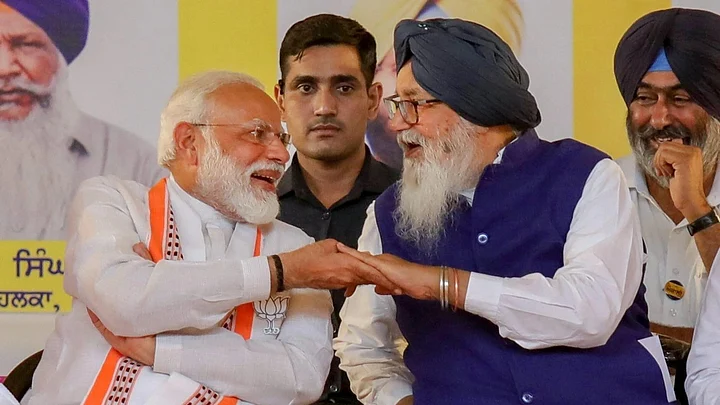Prime Minister Narendra Modi arrived in Chandigarh on 26 April to pay his last respects to former Punjab chief minister Parkash Singh Badal, who passed away in Mohali on Tuesday.
The Modi government also declared a two-day national mourning.
This gave an indication of the close bond that the two leaders shared. However, their equation wasn't without its complexities. We will look at both these aspects in this piece.
How Parkash Singh Badal and Narendra Modi Got To Know Each Other in the Mid 90s
Modi got a chance to closely interact with Parkash Singh Badal when he was posted as BJP's national secretary in-charge for Punjab, Haryana, Himachal Pradesh and Jammu and Kashmir in 1996. His job involved being in Chandigarh for long stretches and it in this context that Modi cultivated an equation with Badal.
As Badal had already been CM before and was several years senior, Modi claims he always looked towards him as a father figure and a guide. He similarly developed a good rapport with Om Prakash Chautala in Haryana and Prem Kumar Dhumal in Himachal Pradesh.
The SAD-BJP government came to power in Punjab in 1997, when Modi was the in-charge. Around the same time, BJP also became part of a coalition government in Haryana along with INLD and came to power on its own in Himachal Pradesh.
This highly successful stint led to a promotion for Modi and he was appointed as BJP's general secretary (organisation).
Modi maintained his friendship with Badal even when he became the chief minister of Gujarat.
After being declared the party's PM face in 2013, Badal was one of the first BJP allies that Modi reached out to.
Unlike Nitish Kumar who quit the NDA over Modi's candidature and the Shiv Sena's support for Sushma Swaraj, Parkash Singh Badal was unequivocal in his support for Modi.
Badal also welcomed the 'clean chit' given to Modi in the 2013 riots. However, things begun to change after Modi became PM in 2014 and more so, with Amit Shah becoming the party president.
Change After 2014
Even after 2014, relations remained cordial with the Badals and Parkash Singh Badal was given the second highest civilian honour - Padma Vibhushan - in 2015. However, under Modi and Shah, the BJP's main priority became its own expansion, even if it was at the expense of allies.
There was a sense in the BJP and the RSS that while Badal had given them a slice of power in Punjab, he had constrained their rise in the state and didn't allow BJP to grow beyond its urban Hindu base.
There was also resentment that that Badal didn't try harder to get the Akal Takht to take back its Hukamnama telling Sikhs not to associate with the RSS.
On the other hand, the Akalis realised that Modi wasn't of much help as far as getting central funds for Punjab was concerned. In fact some say, the Badal government had better luck on this aspect from the Manmohan Singh government, despite the rivalry between the two parties.
The BJP also felt in the 2014 Lok Sabha elections and more so the 2017 Assembly elections and Gurdaspur bypoll, that the Akalis weren't being very effective in ensuring the transfer of Sikh votes to BJP candidates.
The general reluctance of Sikhs to vote for the BJP under Modi also increased this divide.
After 2017 anyway the Badals were weakened considerably and the BJP leadership increasingly began preparing for a solo future in Punjab. In fact on many issues it seemed that the BJP was more comfortable with Badal's successor Captain Amarinder Singh.
This intensified after 2019. The BJP began cultivating Badals' internal rivals like Sukhdev Dhindsa. Dhindsa was given Padma Bhushan in 2019 even though he was trying to weaken the Badals, still BJP allies at that time.
There was also increasing tussle between the BJP and SAD over control over Sikh bodies like the management of Huzur Sahib in Nanded. As a result, the SAD broke its alliance with the BJP for the 2020 Delhi Assembly elections.
Farm Laws and Their Aftermath
The farm laws introduced in 2020 were the last straw. Though the Badals initially supported it, the wave of public opinion in Punjab forced them to not just retract but to break their 24 year-old alliance with the BJP.
Badal returned the Padma Vibhushan in protest against the farm laws.
Though Modi and Badal never directly attacked each other, it became clear that the BJP and SAD were no longer compatible politically. Under Modi and Shah, BJP was clearly unwilling to make any concessions for the SAD. Meawhile the opinion in the SAD's rural Sikh base itself turned against the BJP much more than ever before.
Now with Parkash Singh Badal's demise, the BJP-SAD equation can change, either for better or worse.
One possibility is that Sukhbir Badal could be forced to go back to the BJP and agree for an alliance on terms that are more favourable to the saffron party.
A possible trade-off could be BJP contesting 5-6 Lok Sabha seats instead of 3, in return for SAD getting the lion's share of seats at the Assembly level.
The second possibility is that the Sikh religious leadership would exert much greater influence on the SAD's affairs and push for an even stricter anti-BJP stand from the SAD, especially with control over Sikh bodies being a major bone of contention between the two parties.
